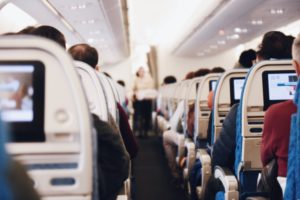Why is it important?
Transport has the highest reliance on fossil fuels of any sector and accounted for 37% of CO2 emissions from end‐use sectors in 2021. (1) Almost 40% of particulate matter (PM2.5) comes from transport. (2) Business and professional travel account for 15% of travel globally. (3) (4) The share of international travel by air has increased from 46% in 2000 to 58% in 2018, while international land transport has decreased from 49% to 39% in the same period (train travel representing 2% in 2018).
Business air travel is one of the greatest contributors to an organisation’s carbon footprint. This is especially true for the aid sector, which provides assistance worldwide. Meetings, training, missions, evacuations, home leave – people travel for many reasons. These travels by plane have a carbon footprint that needs to be reduced across institutions, and where indispensable, they must conform to sustainable travel norms.
What is the solution?
If a flight is unavoidable, more fuel-efficient journeys must be preferred. Great reductions to carbon emissions can be achieved by choosing direct flights over connecting flights, as they offer a shorter route and save fuel on landing/take-off cycles. Direct flights also provide a more direct flight path, with no necessary detours. A study conducted in the United States (5) found that 40% of the reduction is due to shorter routes and 60% accounts for the landing and take-off cycle.
The ‘Direct flights only’ solution is relatively easy to implement, and benefits the travelling staff. It is easily measurable, reportable, and verifiable.
Point of attention
-
Point of attention
Direct flights refer to non-stop flights only – stopovers use more fuel even if the passenger stays in the same plane.
Key actions
-
#1 Create a direct flight priority rule
Update or create the organisation’s travel and expense policy and include a direct flight priority rule (where direct flights exist) for all airline tickets. Connect with the travel agency to implement this rule for all travel bookings.
-
#2 Exceptions should be rare
Only make exceptions for flights which present extreme cost differences, and for itineraries where direct flights are not offered.
-
#3 Decision making for extreme costs
Create a decision tool that establishes acceptable additional costs for direct flights. This can be based on a percentage of the baseline cost (25% additional cost, for example) or on a fixed amount.
-
#4 Quantify the gains
Quantify the gains achieved, through a carbon tracker tool, for example.
-
#5 Mitigate costs
The organisation must also recognise and accept that some extra cost may occur. Good planning is essential to book flights early and save on plane ticket costs. Include a policy that requires employees to book their flight within 10 days of receiving their travel assignment, for example.
-
#6 Communicate and raise employees’ awareness
Raise employees’ awareness on the importance of direct flights. The success of the policy depends on the staff’s understanding and participation, as they often book their own flights.

To consider
-
Potential co-benefits
- Reduction of travel time
- Employees being more rested when arriving at their destination
- No baggage transfer needed
- Reduced risk of missing a connecting flight
- Reduced hotel costs associated with long transfers (scheduled or due to delays)
- Reduction of air and noise pollution
-
Success conditions
- Staff awareness raising about the importance of direct flights
- Involve the organisation’s leaders in the decision-making process to ensure their acceptability
- Book flights in advance in order to mitigate costs
-
Prerequisites & specificities
- To implement this solution, the organisation’s travel policy must be adjusted along with the travel booking tool
-
Potential risks
- Direct flights can be more expensive
To go further
-
Travel policy guide, Stay Grounded, 2020
A guide for organisations who wish to reduce the climate impact of their air travel
Read here
Professional travel

Transport

Sources
(1) International Energy Agency, “Improving the sustainability of passenger and freight transport”. Read here.
(2) European Environment Agency, “Air pollution sources”. Read here.
(3) World Tourism Organisation, “International Tourism Highlights”, 2019. Read here.
(4) López, Ana M., “Expenditure of business tourists worldwide from 2001 to 2021”, Statista. Read here.
(5) Debbage, Keith G., and Neil Debbage, “Aviation Carbon Emissions, Route Choice and Tourist Destinations: Are Non-Stop Routes a Remedy?” Annals of Tourism Research 79, 2019, p. 102765. Read here.
(6) Debbage, Keith G., and Neil Debbage, “Aviation Carbon Emissions, Route Choice and Tourist Destinations: Are Non-Stop Routes a Remedy?” Annals of Tourism Research 79, 2019, p. 102765. Read here.
(7) Tuppen, Holly, “Is there a sustainable way to fly?” The Independent, 2021. Read here.
(8) Calculated with ICAO’s Carbon Emission Calculator. Consult their website here.
(9) Stay Grounded, “Community of Grounded Organisations”. Read here.
(10) Stockholm Environment Institute, “TR2AIL”. Read here.
Cover photo © William Bayreuther/Unsplash.
